
By Steve Hermann
Each year, hundreds of fire departments around the nation participate in exercises to test their readiness for hazards ranging from hazardous materials spills to mass casualty incidents and severe flooding. Most major exercises are funded with federal grant dollars from several sources and administered in each state, usually by emergency management agencies or the state fire marshal’s office. All of these grant-funded exercises are required to be conducted in accordance with the Department of Homeland Security’s Homeland Security Exercise and Evaluation Program (HSEEP).
Most participants are not familiar with the HSEEP and don’t realize that it contains material that can increase their department’s readiness, even when it is not participating in grant-funded exercises. Let’s examine what the HSEEP is designed to do; see what it contains; and look at several multiagency, full-scale exercises to see how it applies. I will focus on a full-scale exercise in Astoria, Oregon, involving a simulated anhydrous ammonia release from a highway cargo tank (photos 1-4), and another exercise in Harney County, Oregon, simulating an explosion and chemical spill (photos 5, 6).
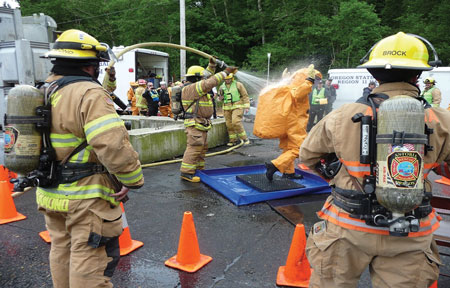 |
| (1) Hazardous materials entry team members undergo decontamination after successfully shutting a leaking valve on an anhydrous ammonia delivery truck discharging vapors to the environment. Space in the exercise area was limited, so distances were compressed. (Photos by author.) |
HSEEP Document
You can download the 71-page HSEEP document, published April 1, 2013, for free at http://www.fema.gov/media-library-data/20130726-1914-25045-8890. The Federal Emergency Management Agency states: “The Homeland Security Exercise and Evaluation Program (HSEEP) provides a set of guiding principles for exercise programs, as well as a common approach to exercise program management, design and development, conduct, evaluation, and improvement planning.”
The HSEEP document’s chapters are organized as follows:
Chapter 1: HSEEP Fundamentals. Describes the basic principles and methodology.
Chapter 2: Exercise Program Management. Provides guidance for conducting a training and exercise planning workshop and developing a multiyear training and exercise plan.
Chapter 3: Exercise Design and Development. Describes the methodology for developing exercise objectives and documentation; conducting planning meetings; and planning for exercise logistics, control, and evaluation.
Chapter 4: Exercise Conduct. Provides guidance on setup, exercise play, and wrap-up activities.
Chapter 5: Evaluation. Provides the approach to exercise evaluation planning and conduct through data collection, analysis, and development of an after-action report.
Chapter 6: Improvement Planning. Addresses corrective actions identified in the exercise improvement plan and tracking corrective actions to resolution.
The HSEEP is built on a progressive approach—a multiyear exercise program that allows departments to participate in a series of increasingly complex exercises, each building on the previous one until the departments achieve mastery. The program uses two types of exercises: discussion-based and operations-based.
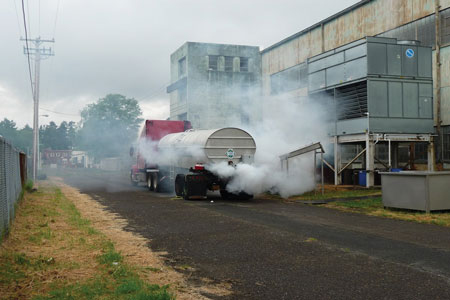 |
| (2) A smoke machine simulates an anhydrous ammonia vapor leak from a delivery truck. The correct U.S. Department of Transportation specification cargo tank used for anhydrous ammonia was not available, so another tank simulated it. Full-scale exercises are usually conducted in a real-time, stressful environment to simulate a real incident. |
Discussion-Based Exercises
Discussion-based exercises include seminars, workshops, tabletop exercises (TTXs), and games. You can use these exercises to familiarize players with or develop new, plans, policies, agreements, and procedures. Facilitators or presenters usually lead the discussion, keeping participants on track toward meeting exercise objectives.
Seminars. Seminars generally provide an overview of strategies, plans, policies, procedures, resources, concepts, and ideas. Seminars can be valuable for departments that are developing or making major changes to existing plans or procedures.
Workshops. Although similar to seminars, workshops differ in two important aspects: participant interaction is increased, and the focus is placed on achieving or building a product. Products that come out of a workshop can include new standard operating procedures, emergency operations plans, and mutual-aid agreements. To be effective, workshops should have clearly defined objectives, products, or goals and should focus on a specific issue.
TTXs. A TTX generates discussions of various issues regarding a hypothetical, simulated emergency. You can use TTXs to enhance general awareness, validate plans and procedures, or assess the response to and recovery from an incident. Generally, TTXs are aimed at identifying strengths and areas for improvement. They can range from basic to complex. In a basic TTX (such as a facilitated discussion), the scenario describes an emergency. As a group, players address a list of problems presented by the facilitator; a resolution is reached and documented for later analysis.
In a more advanced TTX, players receive prescripted messages that alter the original scenario. A facilitator usually introduces problems one at a time in the form of a written message, a simulated telephone call, a videotape, or other means. Players discuss the issues referencing established plans and procedures. Decisions are incorporated as the scenario continues to unfold.
Games. A game is a simulation of operations that often involves two or more teams, usually in a competitive environment and using an actual or hypothetical situation. Games explore the consequences of player decisions and actions. They are useful tools for validating plans and procedures or evaluating resource requirements. During game play, decision making may be either slow and deliberate or rapid and more stressful, depending on the exercise design and objectives. The open, decision-based format of a game can incorporate “what if” questions that expand exercise benefits.
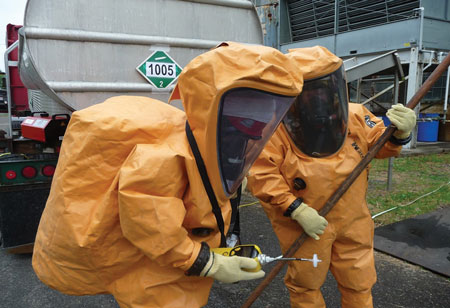 |
| (3) Hazardous materials entry team members in the hot zone take a reading with a photoionization detection instrument. An exercise controller accompanied the team to inform them of the simulated instrument readings. |
Operations-Based Exercises
Operations-based exercises include drills, functional exercises (FEs), and full-scale exercises (FSEs). They can be used to validate plans, agreements, and procedures; clarify roles and responsibilities; and identify resource gaps. Operations-based exercises are characterized by actual reactions to an exercise scenario, such as initiating communications or mobilizing personnel and resources.
Drills. A drill is a coordinated, supervised activity usually employed to validate a specific function or capability in a single agency or organization. Drills are commonly used to provide training on new equipment, validate procedures, or practice and maintain current skills. You can use drills to determine if plans can be executed as designed or to assess whether more training is required. For every drill, clearly defined plans, procedures, and protocols need to be in place.
FEs. FEs are designed to validate and evaluate capabilities or multiple functions. FEs focus on exercising plans, procedures, and staff members involved in command and control functions. In FEs, events are projected through an exercise scenario with event updates that drive activity typically at the management level. An FE is conducted in a realistic, real-time environment. However, movement of personnel and equipment is usually simulated.
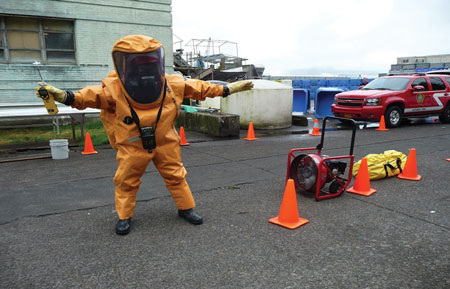 |
| (4) A hazardous materials entry team member undergoes initial gross decontamination from a smoke ejector fan after simulated exposure to anhydrous ammonia vapors in the hot zone. This was followed by a complete wet technical decontamination process. |
FE controllers typically use a master scenario events list to ensure that participant activity remains within predefined boundaries and ensure exercise objectives are accomplished. Simulators in a simulation cell (SimCell) can inject scenario elements to simulate real events.
FSEs. FSEs are, typically, the most complex and resource-intensive type of exercise. They involve multiple agencies, organizations, and jurisdictions and validate many facets of preparedness. FSEs often include many players operating under cooperative systems such as the incident command system or unified command.
In an FSE, events are projected through an exercise scenario with event updates that drive activity. FSEs are usually conducted in a real-time, stressful environment that is intended to mirror a real incident. Personnel and resources may be mobilized and deployed to the scene, where actions are performed as if a real incident had occurred.
The level of support needed to conduct an FSE is greater than that needed for other types of exercises. The exercise site for an FSE is usually large, and site logistics require close monitoring. Safety issues, particularly regarding the use of props, must be monitored. Throughout the duration of the exercise, many activities occur simultaneously.
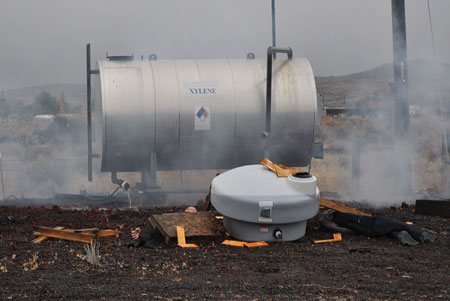 |
| (5) A smoke machine simulates a chemical spill following an explosion in a county chemical and fuel storage yard during a full-scale exercise in Harney County, Oregon. Full-scale exercises are typically the most complex and resource-intensive type of exercise. |
FSE Examples in Two Oregon Counties
In 2015 in Clatsop County, Oregon, an FSE took place involving 12 organizations for a simulated anhydrous ammonia tank truck leak at a seafood packing facility, endangering employees and occupants at a nearby U.S. Job Corps facility. Objectives were developed from areas for improvement in a previous functional exercise in 2014 and included resolving and determining the appropriate agency having jurisdiction for cleanup.
Demonstrating the “progressive approach” HSEEP characteristic, 2014’s functional exercise objectives had been based on “lessons learned” areas for improvement identified in a purely transportation-related TTX with a similar scenario but not involving civilian organizations or fixed facilities.
In Harney County, Oregon, a full-scale terrorism-related exercise took place involving two small municipal volunteer fire departments, a tribal fire department, a state regional hazardous materials team, the Oregon National Guard Weapons of Mass Destruction Civil Support Team, and County Emergency Management. The exercise objectives were selected primarily to address the areas for improvement identified in a TTX earlier that year. The scenario involved a simulated terrorist explosive device on a county fuel storage tank that malfunctioned; the resulting explosion caused a nearby pesticide storage tank to leak (photo 6), contaminating two victims.
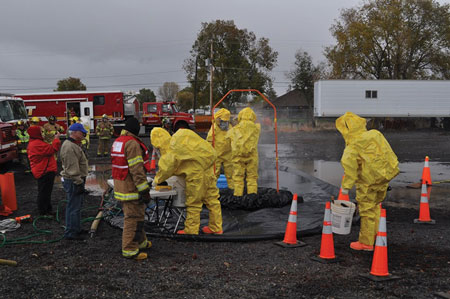 |
| (6) An Oregon National Guard Weapons of Mass Destruction Civil Support Team participated in the decontamination setup and conduct during the multiagency exercise simulating a terrorist explosion and chemical leak. You must monitor safety issues, particularly regarding the use of props. |
In both counties, the HSEEP manual provided a literal step-by-step guidance in the development, planning, writing, conducting, and evaluation of functions to improve emergency response agency performance through an exercise with specific objectives. Both exercises involved U.S. Department of Transportation’s Hazardous Materials Emergency Preparedness Grant funding administered by the Office of the State Fire Marshal and Oregon State Police. This funding allowed for the use of an outside contractor with extensive expertise in exercise conduct and decades of experience in responding to real-world hazardous materials public safety agency emergencies. Employing outside experts also facilitated an even-handed approach to agency relationships and an unbiased assessment of department performance and selection of specific areas for improvement.
Most departments do not have thousands of grant dollars for an exercise, but they can gain the same training and preparedness benefits as did the Oregon departments noted above by following the provisions in the HSEEP manual to develop, conduct, and evaluate their own exercises at whichever level is most appropriate for their training and performance objectives.
STEVE HERMANN, CEM, retired as the hazardous materials coordinator for the Arizona Department of Public Safety. He also served as Arizona’s senior state-on-scene coordinator for hazardous materials emergency response. He has supervised more than 120 serious hazardous materials highway and rail incidents over the past 25 years; has participated in raiding more than 150 clandestine drug laboratories; and has published more than 140 articles during the past 27 years in every major police, fire, and environmental magazine. Hermann is a senior executive fellow at Harvard University’s John F. Kennedy School of Government. He is a retired Army Chemical Corps Colonel in the United States Army Reserves and is a graduate of the United States Army Command and General Staff College and the U.S. Army War College. Hermann has a bachelor of science degree in explosives technology from the University of Minnesota and is a graduate of the U.S. Naval School Explosive Ordnance Disposal. He was a bomb technician under the FBI Bomb Data Program, and he formed and commanded its bomb squad.
Drill Validates FDNY’s Management/Technical Operations Task Force
Homeland Security in America: Past, Present, and Future
What’s New with the 2016 Emergency Response Guidebook
Fire Engineering Archives

